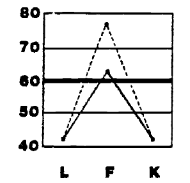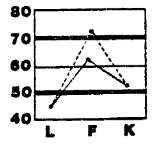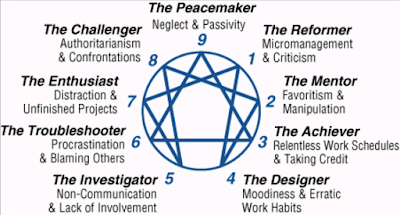The Minnesota Multiphasic Personality Inventory (MMPI-2) is the most comprehensive personality test currently available. Using 567 true or false questions, it rates the tester on 130 categories (validity scales included). Once
validity of the results are established, a
profile is created employing the 10 Clinical Scales: hypochondriasis (
Hs), depression (
D), hysteria (
Hy), psychopathic deviate (
Pd), masculinity/femininity (
Mf), paranoia (
Pa), psychathenia (
Pt), schizophrenia (
Sc), hypomania (
Ma), and social introversion (
Si). Each of these is in itself composed of various other sub-scales.
To take the MMPI-2 free of charge,
click here.
Please note that the MMPI-2 produces
T-Scores and
Raw Scores. What you will be paying attention to are the T-Scores, not the Raw Scores, unless otherwise specified.
T-Scores are not percentages, but may be translated into percentages. Usually, anything above a 75 T-Score denotes a very high ranking on that scale, that is, within the top 1% of the population. Likewise, anything above a T-Score of 65 falls outside the normal range (among the top 3 to 5% of the general population). On the lower bound, any T-Score below 35 would not be considered normal. This general guideline notwithstanding, keep in mind that these point ranges do not apply rigidly, that is, some scales accept certain T-Scores as normal while other scales consider the very same scores abnormal.
Given this complexity, you may find the task of interpreting your own MMPI-2 results overwhelming. I have written this instruction manual with the aim of being as exact, as exhaustive, yet also as simple as possible, such that anyone can do it
and fully understand what they are doing.
How to interpret your own MMPI-2 results?
- Step 1: Verify that your results are valid, and identify what bias these contain, if any.
- Step 2: Once determined valid, see how your profile compares to the rest of the population on the 10 Clinical Scales, and analyze your strengths and weaknesses on each scale by looking at its components.
- Step 3: Pinpoint your dominant psychological defense mechanisms.
- Step 4: Use the supplementary scales to better understand yourself and your current psychological tendencies.
This article explores in-depth how to carry out
Step 1, arguably the most important step because the accuracy of all future steps depends directly on
Step 1 being carried out correctly.
Step 1: Verifying Validity
Are your test results valid, and what do the validity scales say about you?
These are the Validity Scales in the order presented in the results:
? = Cannot Say
VRIN = Variable Response Inconsistency
TRIN = True Response Inconsistency
F = Infrequency
Fb = Backside F
Fp = Infrequency Psychopathology
L = Lie
K = Correction
S = Superlative Self-Presentation
Each of these is described below in detail. Nonetheless, the most important validity scales are
F,
L, and
K.
If
L and
K score higher than
F, it is likely that the test taker attempted to appear healthier than is really the case. This is known as "Fake-Good". However, this pattern by itself
does not make the profile invalid. It might be that the pattern describes a moralistic conformist whose strong defenses allowed them to adapt successfully to the world. Thus, the pattern must be supplemented with further information to determine whether "Fake-Good" actually took place. How to do this is explained below, along with all the scales.
 |
Probable "Fake-Good" slope.
The evaluating entity will treat
your results as overcompensations,
at best, or as outright misrepresentation,
at worst, thus relying on their own view. |
On the opposite end of the spectrum, if
F scores higher than
L and
K, it is possible that the subject tried to appear worse than what they are, which is known as "Fake-Bad". Once again, more information is needed to establish "Fake-Bad" behavior. It could be the case that this person described their current situation sincerely, and perhaps needs professional help.
 |
Probable "Fake-Bad" slope.
The interpreter is likely to believe
that you are acting to gain some benefit
and will treat your results as if they
were manipulative, relying on their own
perception of you for what is deemed true. |
This scale adds how many questions were left unanswered. A high amount of blank responses may signal confusion, resistance to taking the test, or simply that they did not finish.
More than 10 omitted answers risks rendering invalid the totality of the results. If 6 or more questions weren't answered, it would be wise to look at which items these were because there may be a pattern in the topics addressed that may reveal the respondent's level of comfort with an issue or with a psychopathology that they may be unwilling or unable to address.
Some problematic combinations (if the scales listed have a T-Score above 60):
- ? + L = Person is trying to appear in a favorable light but uses a crude strategy to do so.
- ? + L + F + K = Suggests highly-generalized, intense negativism.
- ? + F = The profile is invalid, be it because of reading comprehension problems or mental confusion.
- ? + K = Test taker is very defensive.
VRIN = Variable Response Inconsistency
Measures the tendency to respond inconsistently. There are questions in the MMPI-2 that repeat using different wording. This scale scores the consistency of the answers. On the one hand, an elevated
VRIN and
F indicate that the person answered questions at random; thus,
the profile is invalid. On the other hand, a normal
VRIN coupled with a high
F suggests one of two scenarios: either the person has serious psychological issues that probably require professional attention, or they are simply "Faking-Bad", that is, trying to appear worse than what is actually true. Though a very low
VRIN may be good and indicate outstanding memory and focus, were those traits untrue such a score may suggest that the person is being very careful about lying or portraying themselves as someone they are not. Given the length of the Minnesota Multiphasic Personality Inventory, some response inconsistency is bound to happen to anyone.
TRIN = True Response Inconsistency
Scores whether the respondent answered all true or all false at random. A T-Score above 65 is suspicious. A
TRIN T-Score of 80 or more indicates that
the profile is invalid. This scale needs to be considered along with other scales; it means little alone unless above a T-Score of 80.
F = Infrequency
This very important metric quantifies how much a person's responses deviate from the general population; hence, how infrequent the answers are when compared to everyone else. In a non-clinical setting (if you are taking the test at home under no supervision, you are in a non-clinical setting),
a T-Score above 80 on this scale probably
evidences the existence of a severe psychopathology. To make sure that this is the fact, check that the
VRIN and
TRIN scores are normal, and also compare the
F T-Score with that of
Fb for further confirmation. If
F and
Fb aren't both elevated, it is almost certainly an instance of "Fake-Bad" behavior, that is, of trying to appear worse than one is.
A 65 T-Score on
F is not uncommon; furthermore, being involved in unusual religious, political, or social groups can raise
F as high as 75. Nonetheless, a score of 80 or above, once proven valid, is a clear indication that the test taker is having unusual thoughts and experiences that most likely require professional attention. (In clinical, outpatient settings, a score of 75 is already considered abnormal; in inpatient settings - i.e., in a psychiatric institution - a score of 65 suffices as evidence of abnormality.) An
F T-Score above 100 will elevate all clinical scales (a.k.a., the profile) and is indicative that the person is reacting to everything because he or she is unable to pinpoint a particular problem area, as would happen to a confused mind in the midst of a severe psychosis.
On the flip side, a low
F score denotes a person that is relatively free from stress or major psychological issues, who is dependable, sincere, and may be considered conformist (unless the K and/or L scales suggest a case of "Fake-Good"). Lastly, it should be noted that minorities tend to get higher scores on this scale, and also that it is quite common for creative people to score within the 60-70 range without that entailing psychological issues that must be addressed.
Some problematic combinations:
- Moderately high L and K + really high F = Test may have been answered mostly at random; the profile is likely invalid.
- Similarly, high L + F + K = Responses recorded without considering the questions; profile is invalid.
 |
Invalid profile. The elevations
of L, F, and K together go beyond
anything realistic. Interpretation of results
would be unnecessary and a waste of time. |
- High F + L = "Fake-Bad", that is, the person is attempting to appear worse off than what is true, making the profile likely invalid.
- High F + K = Individual contradicts himself by responding in a self-enhancing and self-deprecating manner at the same time. Lack of insight, confusion, or difficulties understanding the nature of the test may be to blame. The profile may be valid or invalid depending on which of the aforementioned reasons is true.
- High F + Sc (Schizophrenia) = Subject may have a tendency towards withdrawal. Profile is valid.
- High F + Ma (Hypomania) = May have mania or be undergoing a manic episode. Profile is valid.
Fb = Backside F
This scale is the same as
F except that it compiles information from the last third of the questions on the MMPI-2. It is mostly used: 1) to confirm the validity of
F by observing that
Fb T-Scores match
F more or less, and 2) to detect test takers that answer at random because
F and
Fb will show significant disparity.
Fp = Infrequency Psychopathology
This scale was specifically constructed to identify people who are faking a severe psychopathology. A T-Score above
100 on Fp almost certainly renders the profile invalid. Though not necessary,
when such a score is accompanied by a
VRIN T-Score of 80 or more, the
profile is invalid, no ifs or buts about it. The
Fp Raw Score (which is different from the T-Score but is listed alongside it in the results) ought to be 6 or less for an optimal psychological profile to be constructed with the 10 Clinical Scales. This scale is composed of items that not even people with severe psychopathology would assent to.
L = Lie
Lie measures whether an individual is trying to look good or rather is willing to own up to basic human vulnerabilities. A high score means that the subject is claiming socially correct behavior the unreal nature of which is common sense to everyone else.
T-Scores above 60 are rarely seen on this scale. A T-Score of 55 or more may suggest a presentation of moral righteousness. A high
L may signify a naive nature, ill-prepared to deal with difficulties or problems as these surface in real-time.
 |
Profile indicative either of a hysteric
trying to look on the bright side
or of an individual whose psychological
defense mechanisms no longer work. |
An elevated
L with a moderately high
Hy (Hysteria) suggests a character that looks to the bright side, attempting not to think badly about themselves or about other people. Similarly, simultaneous elevated readings on
L,
K, and
Hy points to highly defensive people that may not even be aware of the anomalous degree of their own defensiveness. A high
L can be expected to be accompanied by lower readings on the 10 Clinical Scales profile of the MMPI-2, and, therefore, the results should be interpreted with that bias in mind. If, however, the scores on the 10 Clinical Scales are not all consistently low or in the normal range, this indicates that the person's preferred psychological defense mechanisms are not working well enough to keep a lid on their problems. In contrast, low
L scores are associated with higher levels of education, non-righteousness, and a more relaxed mind.
K = Correction
This scale measures defensiveness in a much more subtle way than Lie. Correctly interpreting
K scores isn't easy as the background of the subject and the conditions under which he is taking the MMPI-2 must be taken into account. College students, for example, typically display T-Scores between a 55 and 70, which signifies that they are competent in managing their lives; if their score is a little higher, it may be that they are on guard because they do not trust their professor or because the reason why they are taking the test wasn't fully or convincingly explained to them. A drop from that scoring range implies that the student is undergoing a stressful time in their lives. Outside of a well-educated population, high
K scores indicate defensiveness. This is true, for example, for job applicants forced to take the MMPI-2; as a result of that peculiar situation, applicants attempt to appear as decent as possible, for obvious reasons, resulting in validity scale charts that typically follow the pattern of the image below.
 |
Typical slope of a job applicant
trying to look better than is actually true.
Though the profile is valid, K-corrections
ought to be applied in order to see what is
more likely the case. Employer should reject
the job applicant, regardless of the K-corrected scores. |
In contrast, a low T-score of 45 or less hints that a psychopathology is probably present (and sometimes this is the only hint that the interpreting psychologist gets when all the profile scales fall within normal bounds). Interestingly, a really low
K of 35 or less correlates with a poor prognosis because it signals that the test taker does not have the tools or the psychological strength to respond well to traditional (no-drugs) therapies, most likely lacking sufficient Ego-Strength (
Es). On the flip side, a really high score also suggests a poor therapy prognosis as the psychological defenses could be so strong that they prevent any internal change or therapeutic progress. Thus, this scale measures how intact the existing psychological defenses are. A corollary of a high score on
K, therefore, is a marked fear of emotional intensity along with an avoidance of intimacy.
Some problematic combinations:
- Elevated L + K + Hy (Hysteria) + R (Repression) = Too defensive to look at the bad in others or see the problems in himself.
- A high K is associated with the psychological defense mechanisms of repression and rationalization.
- When very high Ks co-occur with high scores on one or more of the clinical, profile scales, it is all-too-likely that these individuals will refuse to look at the problem, seeing themselves as having no problems at all.
- If both K and Es (Ego-Strength) record T-Scores of 45 or less, the person will tend not to feel good about themselves and will feel that they lack the skills necessary to tackle their problems.
- When K is below 45 yet F scores below 60, the individual often believes that life has been rough on them because they didn't have the advantages that were available to others. This belief is probably true as this combination usually occurs with people from impoverished or otherwise disadvantaged backgrounds.
- Moderately elevated K + F + Hy (Hysteria) + Sc (Schizophrenia) = Conventional people overly concerned with being liked and accepted into a group, unrealistically optimistic even when the facts do not merit it, have difficulty expressing and receiving anger, and find themselves unable to make decisions that would be unpopular within their group.
- High K + Ma (Hypomania) = An organized, efficient person living with consistent hypomania.
- Moderately high K + high F = People with longstanding psychological issues that have learned to cope with them and adapt to the world successfully, resulting in validity charts patterns like the ones below.
 |
Validity profile of individuals
with persistent psychopathologies
who have nevertheless learned
how to cope and live a normal life. |
S = Superlative Self-Presentation
Highly correlated with
K, this scale is defined by five characteristics: Belief in Human Goodness, Serenity, Contentment with Life, Patience and Denial of Irritability and Anger, and Denial of Moral Flaws. A high score on
S is positively correlated with Ego-Strength (
Es).
If the results appear normal and that of a fully-functional human being but
S has a T-Score less than 65, consider that the subject is "Faking Good"; thus, at worst
the profile is possibly invalid and at best the profile presents a significant bias that ought to be taken into account when interpreting the rest of the MMPI-2 results.
Overview
Congratulations! If you have read and applied the many rules and concepts described above, you ought to have been able to not only verify the validity of your MMPI-2 results but also identify what biases, if any, permeate the rest of your results so that you may compensate for these accordingly in your interpretation of the scores that follow.
I know the task at hand has not been easy... far from it. But I have good news --- you are in luck!
Step 1: Verifying Validity is the most important of the steps; and it is also the hardest (and most technical)
by far. If you managed to complete this step successfully, the rest will be a breeze.
---------------
Other psychological personality tests you may enjoy:


























